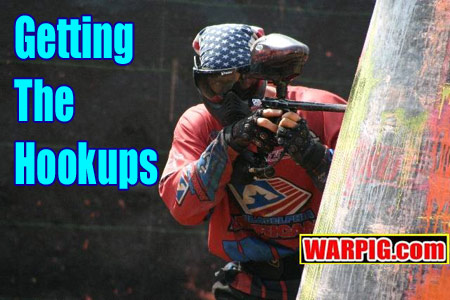  |
|
|
|
|
|
|
  |
|
|
|
|
|
|

What do you think? Add your comments in WARPIG's Forums
|

Getting the hookups: Sponsorship is a two way street By Bill Mills - Jan 2005 WARPIG File Photos By Dawn Mills
That would be the life, to be a sponsored paintball player. Never have to buy a thing again, and itís just paintball day and night. There must be companies out there that just want to hand out a free ride, because if they pay for you to play, then more people will get into paintball and they will make more money, right? You donít have to be a Todd Martinez or Chris LaSoya to land a sponsorship, but you do have to understand what they are if you want to get the hook-ups. In this first installment of a two chapter article weíll look at what paintball sponsorship is, and what it isnít. Thereís no such thing as a free lunch. Sponsorships take many forms in paintball, but the one shape in which you will almost never find them is paintball welfare. Just because a sponsored player or team is getting money or goods from their sponsor does not mean they are getting it for free.
Letís look at a hypothetical sponsorship
request. Joe Longballer is calling up Tim Splatswell from FlyRite
Paintball, to see if he can line up a sponsorship for Team Chupacabras.
[authorís note: While I am using a number of fictional people and businesses
in this article, the numbers and dollar amounts are based on real businesses.]
Joe: Hi Tim, howís it going? You recovered from that wild night in the bar the last night of World Cup?
Easy, itís a ďwrite off,Ē a ďpromotional expense.Ē After all, Tim has a budget at FlyRite for advertising and sponsorships, so this should be a no-brainer, right? Well not really, just like every paintballer, paintball companies have to work on a budget too. They want to put their dollars where they will do the most good. So how good a deal is this sponsorship for FlyRite? After all we know it would be fantastic for Team Chupacabras. In the advertising game itís all about getting your message out to enough of the right people. One of the most common terms used in advertising when comparing dollars to reach is cost per thousand, or CPM (M is the roman numeral for 1,000.) So what is the reach of a Team Chupacabras sponsorship in CPM? Letís see, they will be playing the six events of the MLR, which a little research would show us draws some 40 or so five man teams per event. With an average of 8 people per team (alternates, family members, etc.) we can expect that each tournament will have around 320 people. For a grand total of 1920 people that might see the logo on the jersey. Oh yeah, if Team Chupacabras wins, the 50 or so people who hang around for the awards ceremony might see it a second time. OK, so we divide the cost by the impressions, and find that FlyRite would be paying $6.25 per person who saw the logo, or (multiplied by $1,000) or a CPM of $6,250. The question should be obvious at this point. Is it worthwhile to spend $6.25 a person to show the FlyRite logo to less than 2,000 people? Will that bring in more than $12,000 in sales to make it a profitable move? Now lets compare the sponsorship to some other ways the money could be spent Ė a magazine ad for example. A one page ad in SuperPaintMag that prints 80,000 copies a month will cost around $1,200 and with discounts for a one year contract running the ad for a year is equivalent in cost to the deal Team Chupacabras wants. 80,000 copies of the magazine per issue, times 12 issues gives us 960,000 impressions Ė and these are more than a logo, itís a full color page where we can really talk about how great FlyRite paint is. For the print ad, weíre paying a CPM rate of $12.50. OK, do the math, a magazine ad with
a CPM rating of $12.50 or a team sponsorship with a CPM of $6,250.
Tim: Uh, yeah Joe. Iíve known you for a few years now, and youíve always been a stand-up player. Iíd love to be able to help you but thatís just not a cost effective way for us to promote FlyRite paint. We can probably set up something to give you a price break on paint if you commit to buying all 150 cases of paint you need for the year through Splaterrific, your local FlyRite dealer.
Itís not your dedication that counts, itís the size of your audience
So, if we can apply this to the Chupacabras, letís consider some ways they can improve their CPM. That means either lowering the cost, as Tim did, or raising the amount of exposure the Chupacabras would get for FlyRite. One way to get your mug in all the paintball mags is to win a bunch of major tournaments. But lets get real here, for every Dynasty, there are thousands of other teams youíve never heard of. The chances of an unknown sweeping onto the scene and skyrocketing to the top are extremely slim. Winning tournaments isnít the only way to get an audience Ė being newsworthy is Ė and so is getting to know those who report the news. Playing at national tournaments one is bound to run into people with ID tags that say ďMediaĒ instead of ďPlayer.Ē Taking a minute to give them a friendly hello can make a difference. Hereís a common scenario that Iíve seen
time and time again.
Joe: Hi, Iím Joe, captain of Team Chupacabras.
Slim: Yo, hey itís the Warpig lady.
Thereís more than one way to skin a cat. What a lot of people donít realize is that playing in tournaments isnít the only way to get exposure. Paintball web site and magazine editors all have one thing in common Ė they need content Ė articles and photos for their publications. Most will gladly accept, and often publish freelance submissions Ė a quick e-mail to the editor can find out if theyíd be interested in a topic youíd like to cover.
Publicity isnít the only thing a player or team can offer to a sponsor. Weíll look into other resources a team can use to meet their goals in part two, so stay tuned. Continue to Chapter 2
HERE.
|
| Copyright © 1992-2019
Corinthian Media Services. WARPIG's webmasters can be reached through our feedback form. All articles and images are copyrighted and may not be redistributed without the written permission of their original creators and Corinthian Media Services. The WARPIG paintball page is a collection of information and pointers to sources from around the internet and other locations. As such, Corinthian Media Services makes no claims to the trustworthiness or reliability of said information. The information contained in, and referenced by WARPIG, should not be used as a substitute for safety information from trained professionals in the paintball industry. |